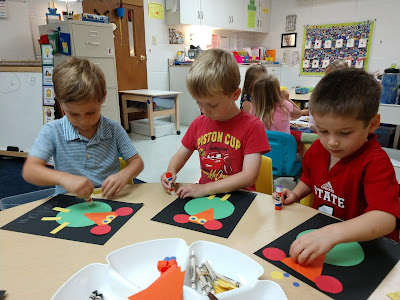"In" ..... "Out"
"Black" ..... "White"
"Open" ..... "Closed"
"Up" ..... "Down"
"Love" ..... "Hate"
So why did we play this game? I explained that opposites are really different from each other, as different as they can be. As we learn more about God, we find that God's ways are sometimes the opposite of what we think.
I told the children we were going to talk about the last set of opposites, Love and Hate.
I held up a picture of a heart and asked, "What do you think of when you see a heart?" Of course, we think of love.
Well, who do you love? Our parents, our siblings, friends and teachers, grandparents... It's easy to love these people because they love us too.
Then I asked, "Has anyone ever been mean to you, or said something that hurt your feelings? What about people who treat us badly or hurt us? Do we love them?" No, that's hard to do. Should we really be expected to love our enemies?
One day, when Jesus was teaching, He said some things that really surprised his listeners. "You have heard that you should love your neighbors and hate your enemies," Jesus said. "But I say love your enemies, and if someone does mean and hateful things to you, pray for them."
Love our enemies? That seems backwards. It's the opposite of what we want to do. Exactly.
Then we read a wonderful book called Enemy Pie.
I don't usually read a book cover to cover at Chapel, but this one is worth it. Enemy Pie the story of a boy who was anticipating a perfect summer, only to have his plans ruined by Jeremy Ross - his worst enemy.
The boy's father offered to help him get rid of his problem and his enemy by baking an Enemy Pie, a recipe so secret that none of the ingredients could be revealed. The boy tried to guess what horrible things might be in the pie, but his father wouldn't say. Still, the boy was sure that this magic pie would do unspeakable things to Jeremy Ross, like make his hair fall out or his breath stinky so he waited for the pie to be done.
After the pie (which smelled delicious - a curious thing for a pie that you would feed to an enemy) was baked and cooling, the boy's father revealed that there was one thing the boy had to do in order for the pie to work. He would have to spend the entire day with his enemy, Jeremy Ross. Even worse, he would have to be nice to him! It sounded hard, but the boy decided he would do anything to get rid of his enemy.
Well, as you might guess, Jeremy Ross wasn't really so bad after all. It turns out that the two boys had more in common than they thought. By lunch, the boy started to think that Jeremy Ross might not be that bad after all. By the time the boy's father had made them macaroni and cheese for dinner, the boy was beginning to think that they should just forget about the Enemy Pie.
Just as his father sliced and served the pie, the boy shouted out, "Don't eat it!" in an attempt to save Jeremy Ross' life. Clearly, he had changed his mind. But after seeing that his father had eaten his slice of pie and was none the worse for it, the relieved boy enjoy the pie with his new friend.
"As for Enemy Pie," he said, "I still don't know how to make it. I still wonder if enemies really do hate it or if their hair falls out or their breath turns bad. But I don't know if I'll ever get an answer, because I just lost my best enemy."
In case you don't have the recipe for Enemy Pie, Jesus offers another solution. He tells us to love our enemies.
Love our enemies? That seems backwards. It seems like the opposite. If someone hurts us, we want to hurt them back. If someone is mean, we want to say a mean word back to them. But love them? No way!
Well, it IS hard if we try to do it all by ourselves. But we have a secret weapon inside of us that helps us to love our enemies - Jesus! God loved us so much that he sent Jesus. When we rely on him to do something that's hard, we can do it. And we just might turn an enemy into a friend!




















